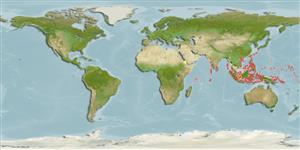Teleostei (teleosts) >
Gobiiformes (Gobies) >
Gobiidae (Gobies) > Gobiinae
Etymology: Pleurosicya: Greek, pleura = side, ribe + Greek, sikya, -as = cucumber (Ref. 45335).
Environment: milieu / climate zone / depth range / distribution range
Ecology
Marine; brackish; demersal; depth range 0 - 22 m (Ref. 90102). Tropical; 30°N - 9°S
Indo-Pacific: India to Moluccas, north to the Ryukyu Islands.
Size / Weight / Age
Maturity: Lm ? range ? - ? cm
Max length : 3.0 cm SL male/unsexed; (Ref. 48637)
Short description
Identification keys | Morphology | Morphometrics
Dorsal spines (total): 7; Dorsal soft rays (total): 8; Anal spines: 1; Anal soft rays: 8. Characterized by head and body translucent green to yellowish green with brown to golden brown bands/bars; male with distinct black blotch on posteriormost part of second dorsal fin; longitudinal scale series 23-29; nape without scales; bilobed tongue; relatively slender body, depth of body at anus averages 6.7 in SL (Ref. 90102).
Inhabits shallow reef flats with algae and seagrass habitats (Ref. 48637). Common on blades of seagrasses (e.g. Enhalus) (Ref. 1602). Feeds on small crustaceans taken from the blades or water nearby (Ref. 37816). Depth range from 0-22 m (Ref 90102).
Life cycle and mating behavior
Maturity | Reproduction | Spawning | Eggs | Fecundity | Larvae
Myers, R.F., 1991. Micronesian reef fishes. Second Ed. Coral Graphics, Barrigada, Guam. 298 p. (Ref. 1602)
IUCN Red List Status (Ref. 130435: Version 2024-1)
Threat to humans
Harmless
Human uses
Tools
Special reports
Download XML
Internet sources
Estimates based on models
Preferred temperature (Ref.
123201): 26.5 - 29.3, mean 28.8 °C (based on 2149 cells).
Phylogenetic diversity index (Ref.
82804): PD
50 = 0.5000 [Uniqueness, from 0.5 = low to 2.0 = high].
Bayesian length-weight: a=0.00724 (0.00339 - 0.01546), b=3.10 (2.92 - 3.28), in cm total length, based on LWR estimates for this (Sub)family-body shape (Ref.
93245).
Trophic level (Ref.
69278): 2.4 ±0.29 se; based on food items.
Resilience (Ref.
120179): High, minimum population doubling time less than 15 months (Preliminary K or Fecundity.).
Fishing Vulnerability (Ref.
59153): Low vulnerability (10 of 100).
